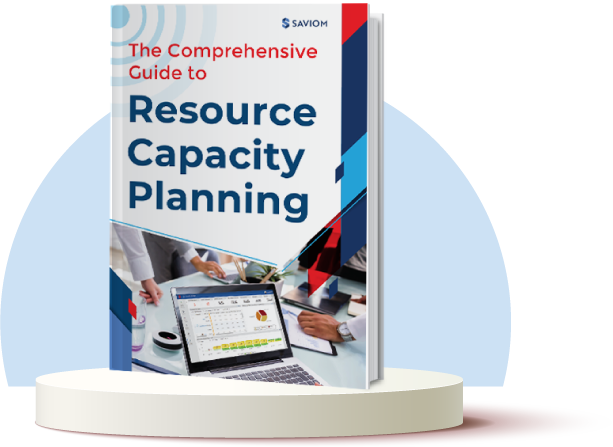Efficient resource allocation plays a significant role in successful project management. That’s why project and resource managers must ascertain that resources are assigned to tasks based on their skills, availability, and interests. However, there are times when resources end up being overallocated due to various factors such as skill shortages, strict deadlines, lack of visibility into schedules, etc.
Failure to address the overallocation of resources can have dire consequences on workforce efficiency and project delivery. It can lead to higher stress levels, burnout, and lower productivity, resulting in project delays.
In this article, we shall explore the impact of the overallocation of resources and effective steps to address them.
What is overallocation of resources?
Overallocation of resources arises when an organization lacks the necessary staff to fulfill tasks or projects within a specified timeframe. In such a scenario, resources are assigned more work than their actual capacity within a given time. This often results in higher work pressure, lower productivity, and poor quality of deliverables, ultimately leading to burnout.
An example of resource overallocation: A resource is booked for 8 hours on one project and 6 hours on another project in one day. However, since the professional only has 8 hours of bandwidth daily, the resource is allocated by 6 hours. Working beyond their allotted capacity can undermine a resource’s productivity, leading to burnout. Therefore, it can eventually hamper the quality of project deliverables.
Now, that we learned the definition of resource overallocation, let’s understand its consequences in detail.

What happens when resources are over-allocated?
The consequences of overallocation can be detrimental to your projects as well as your organization as a whole. Let us look at some of the ill effects of resource overallocation:
Unplanned attrition
Frequently overloading resources with work elevates their stress levels and causes fatigue. If it continues for long, it will lead to burnout, declining their mental and physical health. This will eventually reduce their productivity and lower their morale.
Furthermore, when employees’ well-being is not taken care of, they will feel demotivated and likely look for better opportunities elsewhere. All these factors can lead to unplanned attrition. Such events can potentially halt the project’s progress, causing potential losses for the firm. Moreover, the companies incur extra costs to hire a similar skilled resource without enough lead time.
Subpar employee performance
When the employees are asked to work beyond their capacity, it can lead to disengagement and decreased morale. The typical signs of disengagement and low morale include:
- More prone to mistakes- Frequent mistakes happen mainly due to a lack of focus on work. It may also be due to procrastination due to the fear of not meeting deadlines.
- Lack of enthusiasm and ownership- An overworked employee feels disengaged and avoids participation in regular day-to-day activities, reducing their commitment towards work.
- Missing deadlines- The productivity of an overburdened employee decreases significantly as they struggle to juggle multiple priorities. Consequently, they fail to adhere to deadlines, leading to project delays.
- Lack of collaboration- Overallocation causes ineffectiveness and lethargy in the staff. This may become evident in their unwillingness to collaborate with other team members and eventually become more disconnected.
These factors don’t just affect a single employee’s performance but have a ripple effect on the entire team’s output.
READ MORE: What is Resource Capacity Planning? An Ultimate Guide for Every Project Manager
Employee Burnout
Employee burnout is a direct consequence of overallocation, stemming from the excessive demands on organizational resources. This chronic state of overwork can result in exhaustion, decreased productivity, and heightened stress levels among employees.
A Gallup study revealed that “63% of employees who experience burnout call in sick more often, and 2.6 times as likely to look out for a job change.”
Burnout may cause employees to take more frequent unplanned leaves or mental health days as they struggle to cope with stress and exhaustion. Employee absenteeism can impact operational workflow and cause significant disruption in project timelines.
Inability to meet project deliverables
When resources are spread too thinly across multiple tasks or projects, productivity inevitably suffers. This often results in delays in task completion and, ultimately, project derailment.
Here is what happens when employees are unable to meet the project deadlines:
- The inability to meet project deadlines can lead to discouragement and frustration.
- The wrongful execution of critical project tasks will have a cascading effect on the entire project, eventually bringing it to a grinding halt.
- Mobilizing and altering schedules for one project (that has failed) will compromise and affect the pipeline projects.
- Such shortcomings make employees struggle to meet project demands and hamper timely delivery leading to budget overruns.
Work-life Imbalance
The repercussions of consistently working extra hours often manifest in negative moods and feelings, impacting personal lives and relationships. These may seem like temporary problems, but persistent negative attitudes are a serious red flag. When your workforce does not get time to unplug from work, it leads to frustration and creates resentment towards the workplace.
Such an attitude harms the entire team and productivity, leading to subpar coordination, no ownership of tasks, ineffective communication, and internal conflicts. Moreover, lack of productivity can deteriorate the quality of interdependent tasks. Overall, the work-life disproportion leads to a disruptive workflow and creates an unhealthy work environment.
Loss of business opportunities
Overallocation of resources can lead to a loss of business in a myriad of ways. First, when deliverables are not met on time or within budget, it leads to losing client trust. Unhappy clients would take their business elsewhere, resulting in lost revenue and potential future opportunities. Secondly, overallocation can compromise the quality of work produced.
When project deliverables do not meet client expectations, it can lead to customer dissatisfaction. Lastly, if existing projects consume all available resources, the organization may be unable to take on new clients or projects. This can result in missed opportunities for growth and expansion, ultimately leading to a loss of potential revenue.
Now, that we know the consequences of the overallocation of resources, let’s learn about the strategies that can help us avoid it.
READ MORE: Resource Allocation: A Guide on How to Apply it to Project Management Resource
Ways to avoid resource overallocation
Managers need to avoid resource overallocation and distribute work uniformly to enable optimum utilization. Here are some effective techniques to eliminate overallocation.
Forecast resource availability and utilization
To ensure equitable workload distribution, managers require foresight into resource availability and utilization. For this, they need visibility into resources’ current and future schedules. They can adopt an advanced resource management solution to gain complete visibility of resource attributes such as their skills, capacity, cost, schedules, etc.
Moreover, the robust forecasting capabilities of the tool can help managers accurately forecast resource availability and utilization levels ahead of time. Based on this data, managers can identify and assign competent staff based on their capacity, thus minimizing the risks of resource overallocation.
Use appropriate resource optimization techniques
Managers can apply resource optimization techniques such as leveling and smoothing to address the overallocation of resources. They can use leveling to adjust the start and finish dates of a flexible project based on the availability and capacity of critical resources.
On the other hand, they can use smoothing techniques for time-boxed projects wherein they bring in additional staff to reduce the workload of the resources while maintaining the project schedule. Thus, these techniques allow managers to maintain optimal productivity and project timelines without overloading the team.
READ MORE: What is Resource Optimization? A Complete Guide to improve Project Delivery
Adjust schedules to align with changing priorities
When new priorities emerge, managers must adjust resource schedules to accommodate these changing requirements adequately. Therefore, they must categorize all projects based on criticality and business value and modify resource allocations accordingly.
By doing so, managers can assign key resources to high-priority projects or tasks without overloading them. This allows the resources to focus on the critical tasks first instead of working on all the projects simultaneously. As a result, they can be more productive and deliver high-quality work.
Diversify skills and responsibilities
According to a study, 59% of employees say training improves their overall job performance.
Doing the same tasks routinely adds to the mundaneness and can often lead to disinterest and disengagement. Thus, giving employees different work opportunities allows them to hone their skills while boosting their engagement levels.
Therefore, managers can empower employees to build skills and competencies through training and job rotation. Skill diversification also facilitates succession planning, especially for leadership roles within an organization. It also protects the organization from workflow disruption whenever critical or senior resources exit the company.
READ MORE: How Can Retraining/Upskilling Future-Proof Your Workforce?
Facilitate a change management process
The project scope includes the project’s goals and objectives, deliverables, financials, tasks, and deadlines. If there is a sudden change in the business requirements and the project manager is still expected to deliver using the same resources, it can lead to resource overallocation.
Therefore, it is necessary to define a proper change control process during the project initiation phase. Any substantial changes in the project scope need to be pushed back to the next release. In case that is not possible, approval should be sought to change the delivery timeline or increase the budget. This proactive approach minimizes the chances of resources being overallocated.
Build an on-demand contingent workforce
Overallocation usually happens in a resource-constrained environment where there are insufficient employees to complete the ongoing projects. So, organizations must consider hiring a contingent workforce to alleviate the workload of the existing employees. For this, they can look into the project pipeline and assess the resource requirements in terms of numbers, skill sets, and duration.
Based on this evaluation, they can begin staggered hiring to acquire the necessary skill sets required for project initiation. They can recruit cost-effective local and global on-demand consultants on a part-time or full-time basis. It helps them keep project costs in check while also ensuring that internal resources are optimally utilized without being overworked.
Key takeaways
Resource allocation is a vital aspect of efficient project resource management and, therefore, must be systematically executed. The tips mentioned above will help you achieve optimum allocation and enhance employee productivity.
In addition to the tips, implementing a multidimensional resource scheduler could help avoid double-booking and improper allocation with data-driven insights. Managers must strive to keep their resource’s health in check, as they are the success-drivers of your firm.
What steps do you follow to avoid over-allocation of resources?
The Glossary:
READ MORE :Glossary of Resource Workforce Planning, Scheduling and Management
Saviom Solution
SAVIOM, without a doubt, has become the market leader in offering the most powerful and configurable solutions for managing enterprise resources efficiently. Having more than 20 years of experience, this Australian-based MNC has a global presence across more than 50 countries and an esteemed client list of over 100 customers, helping them achieve their business goals. SAVIOM also has products for project portfolio management, professional service automation, and workforce planning software, which can be easily customized as per business requirements.
Please get in touch with us to discuss your business challenges and significantly reduce project resource costs, increase billable utilization, and more!









